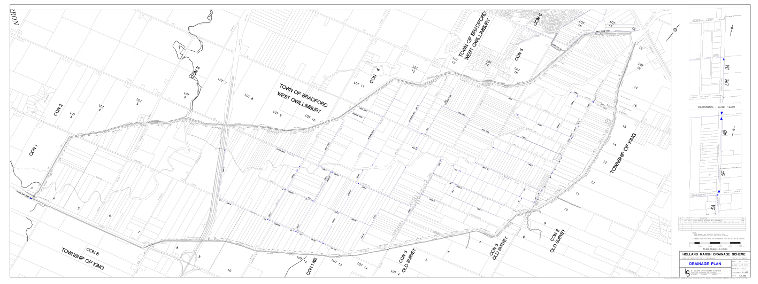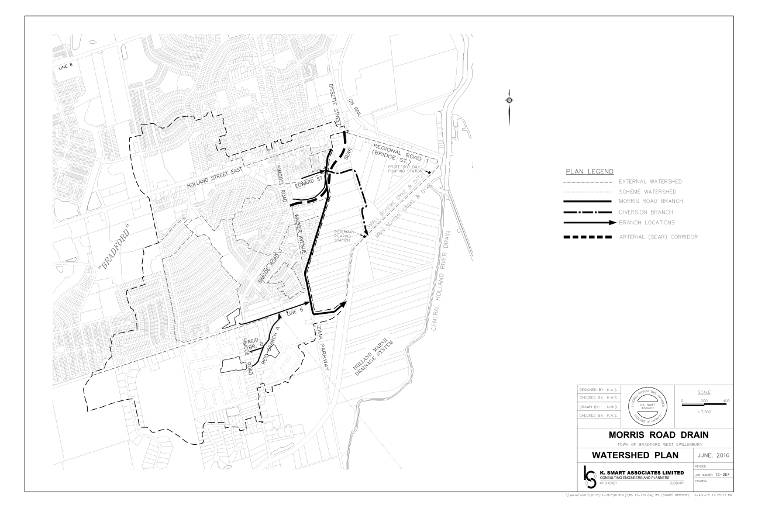The Holland Marsh is an artificially drained area, managed through a network of municipal drains and pumping stations. The Canal System is 28 km in length and the Main Drain is 18 km in length.
The Board maintains approximately fifty five (55) municipal drains and six (6) pumping stations. The Board has established a rotational cycle of maintenance for the internal drains.
The Holland Marsh Drainage Canal Improvement Project is a plan to restructure 28 km of the canal, including total or partial canal relocation, bottom cleanouts, and additional guard rails installed in select areas. Issues of safety, especially with respect to human fatalities and flooding, have been the primary motivations for the approximately $25 million project.
On June 9th, 2010 the Holland Marsh Drainage System Joint Municipal Service Board awarded Contract 10.1 A.A to Daniel Higgs Excavating Ltd. and Higgs and Higgs Inc. to begin work on the Canal Improvement Project. This contract included work along the South Canal from Graham Sideroad to Highway 9 and work on the North Canal from Highway 9 to Highway 400.
Work that was done at South Canal Bank Road, east of Highway 400 included the moving of the canal as well as the construction of a berm. This enhanced the life safety of those driving along the canal and has helped to slow down and prevent future deterioration of the road. Clay and stable earth were brought in for the construction of the berm to enhance the stability of the road.
The two primary reasons for this project were life safety and flood protection in the Holland Marsh. The Marsh would have been flooded out by a 50-year storm event; an event slightly less severe than 1954's Hurricane Hazel. By excavating the canals several feet deeper than specified by the original engineer's report, more water will be able to runoff into the canals.
In accordance with the requirements of the Federal Department of Fisheries and Oceans, fish species were relocated from the construction intervals to other parts of the canal system until their habitat is restored.
The Canal Improvement Project was completed in 2016.
PROJECT TIMELINE OF EVENTS
| 1997 | K. Smart Associates Limited, Engineer, was appointed pursuant to the Drainage Act |
| 1997/98 | Review of past reports, preparation of Preliminary Report including costing |
| 1998/02 | Section 76 of the Drainage Act, report completed allowing assessment to all upstream land including riparian landowners. Public Meetings and Open Houses were held, Section 76 Report approved |
| 2000 | Bradford West Gwillimbury received formal notice pursuant to Section 79 of the Drainage Act to put the dykes and canals into a proper state of repair, failure to do so would hold the municipality liable for all damages should flooding occur |
| 2003 | An engineer was appointed under Section 78 of the Drainage Act to prepare a final engineering report to improve the Holland Marsh Drainage System |
| 2004/08 | Canadian Environment Assessment Act, 2012 (CEAA) study was undertaken with Department of Fisheries and Oceans Canada being the responsible authority. Trial work was undertaken during 2008 |
| 2009 | Final report was received and the public appeal process began |
| 2010 | Report was adopted by Bylaw, construction officially started June |
| 2010/03 |
Engineering Report dated March 12, 2010 (Click on the volume titles below to download/review) |
The Bradford Marsh Small Drainage Scheme was constructed as a Drainage Act project pursuant to a report of A. Baird, CE/OLS dated July 7, 1925. In March, 2013, K. Smart Associates Limited, Engineer, was appointed to undertake Section 76 and 78 work pursuant to the Drainage Act to address the problems related to, and solutions available for, drainage in the Morris Road Drain component of the Scheme. Contractor commenced work in December, 2016 and the project is in its final stages of completion.
The Horlings Drainage Scheme was originally constructed privately on properties owned by G. Horlings in 1953. On May 25, 2013 and June 16, 2013, the northeast portion of the dyke failed and all scheme lands were flooded. Approval to do emergency work pursuant to Section 124 of the Drainage Act was applied for by the Municipality in June 2013. K. Smart Associates Limited, Engineer, was appointed pursuant to the Drainage Act to complete an Engineer's report to address the petition filed to reconstruct the dyke system.
Note: if you received a notice in the mail about River Road Drain, please be advised that all documents related to the project are located towards the bottom of this page.
The purpose of this report is to provide new drainage works along the west side of River Road between Canal Road and Hillsview Road, and on the same west side in the north two thirds between Hillsview Road and Weber Road, and by providing outlet easterly along Hillsview Road to the Central River. The drain will be a combination of a pipe drain and swale drain.
The process we are currently involved in is dictated by the Drainage Act.
Step 1: Engineer's Report
The Board has appointed K. Smart Associates Limited to prepare a report outlining all the aspects on the proposed project including, but not limited to:
- Technical descriptions of the work that is required
- Estimated cost sharing amounts, for all properties owners within the watershed
- Maps of the area
Step 2: Provisional By-law Passed
The Town of Bradford West Gwillimbury Council will adopt a provisional by-law accepting the Engineer’s Report.
Provisional By-law 2020-101 was passed by Council on November 3, 2020, and copy of this By-law is available below. This By-law was also circulated on November 5, 2020 to all property owners within the watershed along with a notice of the Sitting of the Court of Revision.
Step 3: Appeals Are Heard
There are 3 bodies that hear appeals to the report, based on the type of appeal that is brought forward:
Court of Revision
Municipal Level Review
- Appeals to the assessment values found in Appendix B of the Engineer's Report
Tribunal
Provincial Level Tribunal
- Appeals to the Court of Revision's decision
- Appeals to the technical aspects of the report
Drainage Referee
Provincial Level Court
- Appeals to the Tribunal's decision regarding technical aspects of the report
- Appeals to the Legal aspects of the project
Step 4: Final Approval of the Engineer's Report
After all appeals have been addressed appropriately, Town Council will need to give the report a final approval via giving final reading to the by-law in order to authorize construction.
This will be a public process. Should Council give the report final approval, the project will move forward for tendering.
Step 5: Tendering of the Project
The project goes to tender 10 days after the by-law receives final approval.
If tenders come in 33% or more over the estimate provided by the report, Clerks will send a notice to property owners and there will be a public meeting to determine if the project should move forward.
Step 6: Construction of the Project
Step 7: Post Construction Activities
After construction is finished, the Town will work to complete the project by doing the following activities:
- Amending the By-law to reflect actual costs
- Registering the By-law
- Applying for OMAFRA grants on behalf of property owners
Step 8: Final Appeal
Should property owners find the work done by the contractor to be unsatisfactory, appeals can be made to the Tribunal.
There are several documents below that may assist you in better understanding this project. If you would like any additional information regarding this project, please reach out to the Board Co-ordinator at 905-778-4321, or by email at [email protected].
Final Engineer's Report – K. Smart Associates Limited
Important Documents:
- Final By-law 2020-101 – River Road Drain By-law
- Court of Revision Minutes dated December 1, 2020
- Notice of Meeting to Consider the Engineer’s Report
- Provisional By-law 2020-101 – River Road Drain By-law
- Notice of Provisional By-law and Notice of Court of Revision
- Understanding Court of Revision Procedures Under the Drainage Act
The Holland Marsh Drainage System Joint Municipal Service Board passed a resolution on February 11, 2021 to appoint a drainage engineer to develop an updated assessment schedule for the Main Drain and Pumping Operations pursuant to Section 76 of the Ontario Drainage Act, which could allow for variable levy rates based on land use.
Pursuant to Section 76(1) of the Ontario Drainage Act, the Board requires permission from the Agriculture, Food and Rural Affairs Appeal Tribunal to procure a report of an engineer to vary the assessment.
The Holland Marsh Drainage System Joint Municipal Service Board made application to the Agriculture, Food and Rural Affairs Appeal Tribunal on February 24, 2021. The Agriculture, Food and Rural Affairs Appeal Tribunal rendered a decision on June 18, 2021, on the written hearing, which grants permission for the Holland Marsh Drainage System Joint Municipal Service Board to procure a report of an engineer to vary the Schedule of Assessment prepared in 1990 by Young-Smart Engineering Company. The decision is below.
R.J. Burnside & Associates Limited was appointed to review the current levy structure and provide a new levy structure that may create a variable rate for determining assessments against existing lands that have been modified through development (i.e. hardening). The Drainage Engineer may apply the principles of Section 23(3) of the Drainage Act where “The assessment for outlet liability….shall be based upon the volume and rate of flow of the water artificially caused to flow… into the drainage works from the lands and road…”
R.J. Burnside & Associates Limited held an “Information Meeting” regarding the pending update to the assessment schedule on August 9, 2023. The presentation provided by the drainage engineers is below.


